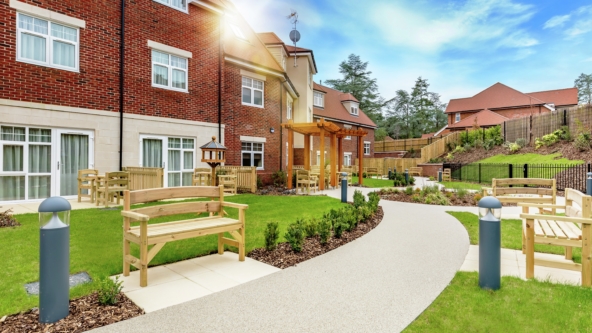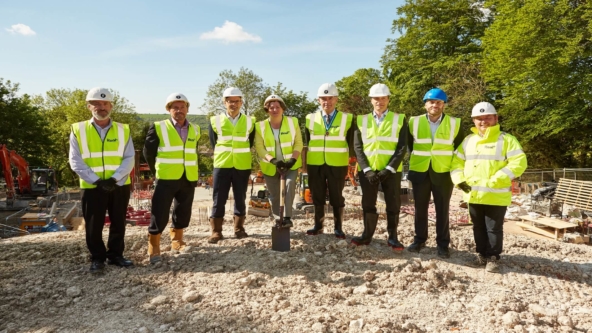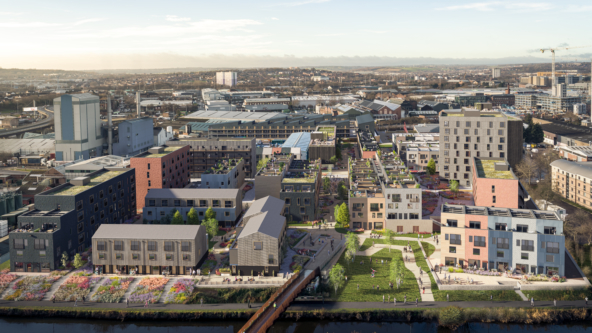Person-centred care: at the heart of how care home design has evolved through the decades
The UK’s care sector continues to expand, with the Government, investors, and operators working to help our ageing population. From developing funding solutions to delivering homes that truly support people, the focus is on better experiences for residents.
Yet while the industry works towards the future, public perception often remains in the past. Negative media coverage may be some people’s only acquaintance with the topic and the emotive nature of care also means that people shy away from the discussion.
The reality is that there are many nuances to how care homes are designed and run. In this article, we will explore the factors affecting how care home design has changed over the years and what this is likely to mean for the future. We will look at:
- How changing styles and the shift towards providing a sense of independence and quality of life for individuals has affected room design.
- The evolving role of technology from almost nonexistence to digital care planning.
- The rise of importance of environmental performance of buildings.
- How improved diagnostic and treatment pathways have changed how certain conditions are recognised and treated.
Ultimately the focus always has, and always will be, on person-centred care.
Improving the quality of life through design
Over the last 60 years, approaches taken by researchers and policymakers to care homes and their residents have been influenced by social concerns and growth in the fields of psychology and sociology.
In the early 1960s landmark studies, such as that conducted by sociologist Peter Townsend for his survey The Last Refuge (1962), revealed poor conditions in care homes. Meanwhile, the work of figures such as social psychologist Irving Goffman and social theorist Jean-Michel Foucault built on psychiatric work in the 1950s. Highlighting the impact of institutional living on people including care home residents, this heralded a move towards community-based care.
Improvements in care home design were brought about by mandatory requirements for central heating, single rooms and en suite lavatories. In subsequent decades benchmarks for standards of amenity were the ratio of single to shared rooms and the proportion of rooms with an en suite. In a report published in 2002, health economist William Laing found that from the late 1980s to the early 2000s conditions improved to the extent that 80% of rooms were single, and en suites were included in nearly 50% of bed spaces.
From the late twentieth century, these basic developments were accompanied by the addition of features such as easy-to-access bathroom equipment, hoists and electronic lifting chairs. Aside from covering practical issues, these regulatory changes offer a way to help residents navigate their surroundings and maintain dignity and independence.
Fast forward to the 21st century and care homes across the UK and Europe are sharing best practice and a vision of the future. An ideal care home is one that leaves institutional settings behind, instead feeling modern, fresh and fit for purpose.
The inclusion of amenities such as hair and nail salons, cinema rooms, games rooms, spa bathrooms, shared spaces for meals and socialising as well as manicured outdoor gardens create a sense of enjoyment and fulfilment. They encourage social interactions, movement around the home and better mental wellbeing for residents as well as their visiting friends and relatives. Care home operators understand that ongoing investment in facilities such as these creates ongoing demand from potential residents, securing the future prospects for a care home. Operators moving with the changing times recognise that they have to offer a lifestyle choice that can offer supportive residential care through to complex nursing care.
Care home design enhanced by technology
Technology has played a major role in improving care homes. From a complete absence of technology in the 1960s to perhaps one computer in a home in the 1990s, the industry is now arriving at full digital care. Over the last twenty years in particular, technological advances have brought benefits to residents and staff. They have also been integrated into policy, which helps increase the adoption of change across homes.
Facilities for acoustic monitoring, along with digitised locking systems can ensure greater protection of resident movements. WIFI and video calling technology aids independence and connectedness to friends and relatives. It also allows for tech-enabled health services including telehealth and digital care planning. These changes bring about operational benefits and improved monitoring of residents.
In some technologically-advanced homes, integrating the built environment with the Internet of Things (IoT) sees even more possibilities become realisable. Wearable technology enables health monitoring, from heart rate to steps taken and more.
Tech allowing staff to capture and record data means they can deliver real-time updates on residents, ensure digital records are held centrally and improves trend analysis by senior teams. In turn, this enables a streamlined approach compared to paper-based methods and increases the standards of care.
Technology will remain a driving force in care home design. A report from Anchor (2015), set out possibilities including ambient monitoring walls, rotating gardens, virtual pets, and 3D hologram computers incorporating voice-activated commands. However it comes to be used, technology that becomes successful will be based on residents’ needs.
Addressing environmental performance
Sustainable technology specifically has been integral to improving the environmental performance of care homes. Reducing energy bills as part of viable business models has historically been important for cost reasons, but societal shifts have moved this up the agenda to now be a point for public discussion. This presents a unique challenge for care homes, operating a 24/7 business model that requires above-average temperature conditions for elderly residents.
UK targets to reduce carbon emissions, together with investor demand for sustainable buildings, make this a broad concern. As a result, UK care homes have had to make strides in this area over the last ten years.
Starting points have included increasing insulation in buildings, along with access to green spaces surrounding them. Many homes have gone on to replace oil and electric heaters with biomass wood-chip boiler systems. They have also installed solar thermal panels, combining these in some cases with underfloor ground source heat pumps.
The Government’s Renewable Heat Incentive, introduced in 2014, allows homes to be paid for every unit of heat produced through renewable technologies. This has boosted activity, allowing homes to gain income.
Care homes have also come a long way in how they handle by-products of their operational business. In previous decades, waste management wasn’t really a term ever discussed by management let alone monitored or reported on.
In modern society, with the ability to extract value from waste by separating types of materials and consider rebate models with responsible waste management providers, there’s an increased focus on how waste is collected. This extends to excess use of consumables such as water, in addition to procurement considerations for the supply chain. Some homes actively seek out suppliers who have a commitment to more environmentally friendly packaging and products, as well as those which commit to lowering carbon footprints in their production values.
Looking forward, as pressures from climate change increase, and investors look for more reassurance on the sustainability of real estate, factors such as building performance will become increasingly important considerations.
Improvements in diagnoses and understanding of later life conditions
Technology and sustainability are important themes in care home design. But other macro factors affecting the homes include the detection and treatment pathways of medical conditions experienced by residents, with great advances being made specifically in the areas of People living with dementia and Alzheimer’s.
It is currently estimated that the number of people in the UK with dementia stands at 850,000 (Source: NHS England). Of these, 537,097 have now received a dementia diagnosis (Source: England: NHS Digital; Recorded Dementia Diagnosis Data May 2019. [Multiple sources for Wales, Scotland and Northern Ireland*])
The work of not-for-profit organisations in shaping government policy has contributed to an improvement in the proportion of people with dementia who received a dementia diagnosis. The Alzheimer’s Society, formed in 1979, has led on raising awareness of dementia, its impact on individuals, the cost to society, and the Government’s responsibility in addressing it.
The Government’s Challenge on Dementia 2020, launched in 2015, aimed to make the UK the best country in the world for dementia care and research. Its goal, for two-thirds of the estimated number of people with dementia in England to have a diagnosis with appropriate post-diagnostic support, was first achieved that year. There are also now dozens of dementia research projects based in the UK (Source: NHS England).
Evidence-based dementia design principles for care homes have also been in existence since the late 1990s. These have included manageable cognitive load, clear sequencing and appropriate levels of stimulation.
Colour and lighting play an important role in the ability to navigate space, from simple measures such as colour coded, labelled doors to more advance methods including motion-sensitive floor tiles directing residents step-by-step to the bathroom in the night. As we understand more about macular degeneration and the importance of colour contrast with dementia patients, we have adapted the nature of furniture and signage used in care homes. Surfaces and textures have been re-designed as we appreciate the role of touch and physical stimulation on cognitive behaviours. Touch/ motion sensitive products can be used on table surfaces to encourage play, engagement and physical rehabilitation.
In outdoor spaces, gardens are designed to stimulate multiple senses, with plants which rustle, varying colours, textures, scents and heights. Various pathways offer residents the option of choosing how they would like to move around the space, supported with regular places to stop and rest with seating, which imparts an increased sensation of independence. The importance of perimeter fencing to secure movements of residents is now balanced with the aesthetics of encouraging views of an active world and nature.
The future of care home design
With care home design often advancing behind closed doors, it’s a shame that the public perception remains skewed towards old stereotypes. Exploring these ever-changing themes and the scale of progress which has been made in recent years highlights an exciting and dynamic future for the sector.
Certainly, we have learned from recent events involving the pandemic that the use of facetime and zoom on tablets can have a wonderful effect on both residents and staff. Previous fears of “will residents understand it” have been overcome, families and friends have been able to communicate more and staff teams have felt better connected.
The challenge for those investing in and building care homes is how to balance the application of evolving designs that benefit elderly residents with economic and environmental performance concerns. However, it is vital that they do. The number of people over 65 receiving care in residential settings across all sectors is now estimated at over 390,000 (Source: LaingBuisson Care Homes for Older People 30th edition). As our ageing population grows, along with the prevalence of later-life conditions, the need for fit-for-purpose care homes will become even more pressing.
The role of funds which invest in modern, purpose-built care homes that are future-proofed is critical. And as we continue working to deliver homes, what will remain at the heart of each project is a focus on person-centred care.
Sources
Please note: Relevant websites are referenced within the text. Further key articles and reports are listed below.
The development of residential and nursing home care in the United Kingdom
The origins and development of social care https://www.kingsfund.org.uk/sites/default/files/Securing_Good_Care_Chapter_1.pdf
Here’s what the care homes of the future should look like
https://www.theguardian.com/social-care-network/2017/jul/31/care-homes-future-paul-burstow
Silver Chic – What will the retirement home of the future look like?
https://www.anchor.org.uk/media/silver-chic-what-will-retirement-home-future-look
Roundtable: Design for the mind
https://www.carehomeprofessional.com/roundtable-design-mind/
*Wales: General medical services contract: Quality and outcomes framework 2017/18. Scotland: Information Services Division; Quality and Outcomes Framework General Practice. Northern Ireland: Department of Health; 2017/18 raw disease prevalence trend data for Northern Ireland).


